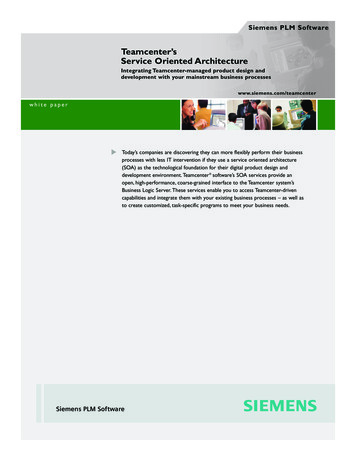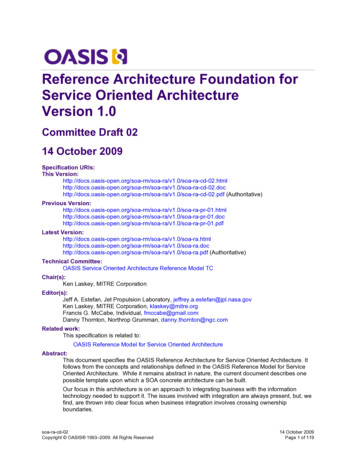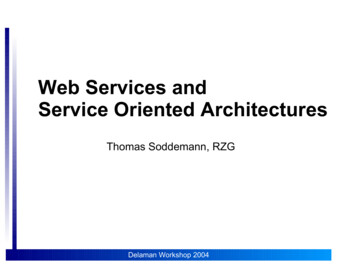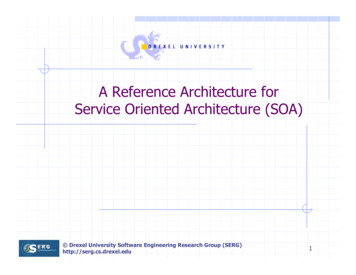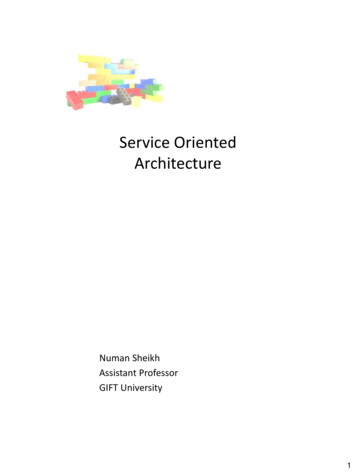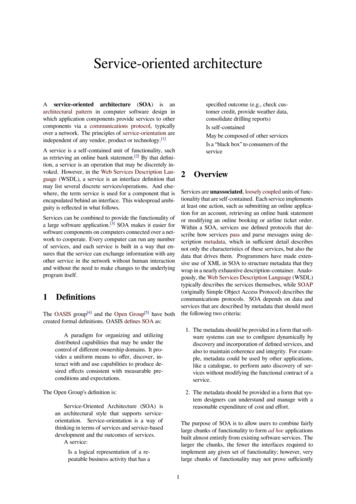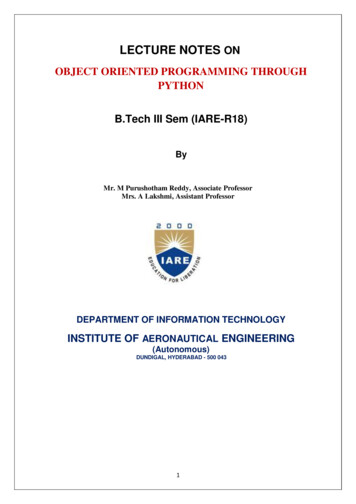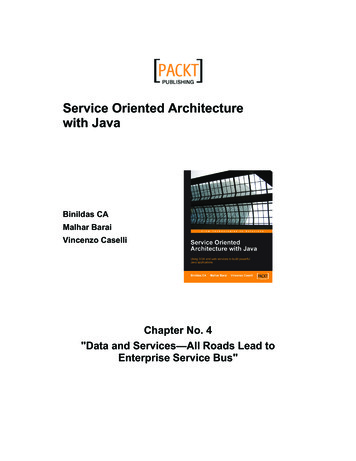
Transcription
Service Oriented Architecturewith JavaBinildas CAMalhar BaraiVincenzo CaselliChapter No. 4"Data and Services—All Roads Lead toEnterprise Service Bus"
In this package, you will find:A Biography of the authors of the bookA preview chapter from the book, Chapter NO.4 "Data and Services—All Roads Lead toEnterprise Service Bus"A synopsis of the book's contentInformation on where to buy this bookAbout the AuthorsMalhar Barai is a senior systems analyst with Satyam Computer Services Ltd., one ofIndia's leading IT services organizations. He has more than seven years of experience inthe industry working for leading organizations across India.Malhar has interest in service-oriented technologies and application integration tools. Hehas worked on EAI toolset of webMethods and Cast Iron, Java technologies.You can catch him on various forums that deal with SOA and some of the webMethodsforums, or you can read about him on his blog http://malharbarai.blogspot.comHe gets spurred by the daily challenges at work, finding solutions to the problems, andtrying his hand at improving processes and solutions.I would like to acknowledge and dedicate this book to my parents forbeing sources of inspiration and for guiding me on the right path whenit mattered the most. To Jalpa, my lovely wife for, being a constantsupport and carving out a wonderful life for us. My ex-manager AjayMulkalwar for his guidance and encouragement, and the mostimportant person—my soul, my sweet daughter Preisha whose lovelysmile makes my time wonderful For More itecture-for-java-applications/book
Vincenzo Caselli graduated with a degree in electrical engineering in 1991 from theUniversity of Bologna. He has worked as an independent consultant and a Java trainerfor several Italian software houses since 1996. He began working as a developer inDelphi and other visual IDE's with AS/400-based companies. Soon he shifted his focuson Java and began to propose Swing client/server multi-layered solutions to hiscustomers. He also worked in the web development area with several frameworks(Struts, Hibernate, Spring, JSF, and GWT) in different fields (banking, manufacturing,healthcare, e-learning). Recently, he collaborated with IBM in projects based onEclipse RCP and SOA. He is interested in consultancy and training activities aimed toimprove the productivity and quality of the software development process by usingopen-source products.I would like to thank my wife Silvia and my daughter Linda for beingpatient while I worked on this book. I also want to thank my friendLuca Masini for his precious technical advice and help.Binildas C. A. provides Technical Architecture consultancy for IT solutions. He hasmore than 13 years of IT experience, mostly in Microsoft and Sun technologies.Distributed Computing and Service Oriented Integration are his mainstream skills, withextensive hands-on experience in Java and C#.NET programming. Binil holds a Bachelorof Technology degree in mechanical engineering from the College of Engineering,Trivandrum (www.cet.ac.in) and an MBA in systems management from Institute ofManagement, Kerala (www.imk.ac.in). A well-known and a highly sought-after thoughtleader, Binil has designed and built many highly scalable middle-tier and integrationsolutions for several top-notch clients including Fortune 500 companies. He has beenpreviously employed by multiple IT consulting firms including IBS Software Services(www.ibsplc.com) and Tata Consultancy Services (www.tcs.com), and he currently works forInfosys Technologies (www.infosys. com) as a Principal Architect where he heads the J2EEArchitects group servicing Communications Service Provider clients.Binil is a Sun Certified Programmer (SCJP), Developer (SCJD), Business ComponentDeveloper (SCBCD) and Enterprise Architect (SCEA), Microsoft Certified Professional(MCP), and Open Group (TOGAF8) Certified Enterprise Architecture Practitioner. He isalso a Licensed Zapthink Architect (LZA) in SOA. Besides Technical Architecture, Binilalso practices Enterprise Architecture.When not in software, Binil spends time with wife Sowmya and daughter Ann in 'God'sOwn Country', Kerala (www.en.wikipedia.org/wiki/Kerala). Binil is a long distance runnerand is a national medalist in power lifting. You may contact Binil at biniljava@yahoo.co.inor binil christudas@infosys.com.For More itecture-for-java-applications/book
Service Oriented Architecturewith JavaService Oriented Architecture is mainly a mindset, an enterprise strategy whose naturalimplementation is represented by web services. SOA is not a single product or singlereference architecture to be followed, but SOA is all about best practices, referencearchitectures, processes, toolsets, and frameworks, along with many other things whichwill help you and your organization to increase the responsiveness and agility of yourenterprise architecture. Standards and frameworks play a greater role in enabling easyand widespread industry adoption of SOA.This book will help you learn the importance of designing a sound architecture forsuccessful implementation of any business solution, different types of C/S architecture,and various tenets of SOA, explaining the fundamentals and explaining the advantage ofusing the Service Oriented Architecture in designing of the business solution. From abasic XML-over-HTTP approach to the REST and SOAP protocols, we get into thedetails of how web services can be implemented with various degrees of complexity andflexibility using JAVA.This book will explain the concepts of business layer that is 'The SOA core'. Youwill also learn when SOA will define as an asset to your project with the help ofpractical examples.In the early years when the WS-approach began to emerge it suffered from difficultiesdue to many factors, for instance, complex adoption process and poor standardization.Now, with little effort times are mature for using this technology and also getting greatadvantages, both immediate and as an investment for our future works. The bookconcludes with the focus on explanation of these assets.For More itecture-for-java-applications/book
What This Book CoversIn Chapter 1 we will discuss the role of Architecture for successful implementation ofany business solution followed by brief discussion on different types of client-serverarchitecture and SOA.In Chapter 2 we will examine the relationship between the SOA methodology and theweb service implementation basics. We will also discuss how XML can be used as thecommon language to decouple the communication between web service implementationsand their consumer clients.In Chapter 3 we will introduce major web service implementations available specificallyin the Java and J2EE world, WS using JAX-WS 2.0, WS using Apache Axis, WS usingSpring, and WS using XFire.In Chapter 4 we shall see few emerging standards like SDO and SCA, addressing fromdata integration to service and component integration.In Chapter 5 we will look into a couple of case studies where one of the solutions isbased on principles of Enterprise Application Integration and in the second one we shallbuild our solution based on SOA fundamentals.In Chapter 6 we will explore in detail the advantages that the SOA approach can lead to.Basically a concluding chapter discussing what we can and what we have achieved withSOA approach.For More itecture-for-java-applications/book
Data and Services—AllRoads Lead to EnterpriseService BusHaving seen the basics of XML and XML-based services in the previous chapters,we are now ready to look into the big picture of enterprise landscape and see howall the pieces fit together. What is of interest for every enterprise user is informationand every information starts from the basic building block, data. Data can residein any data store, and can exist in many formats. Irrespective of that, you need tobring data to your table, do some massaging with your business use cases, andsupply them as information. How do we do that in the SOA world, moving awayfrom the traditional JDBC or Object-relational mapping (OR mapping) styles? Andmore interesting is, data can even exist in the form of services and if so, how dowe combine multiple services just like we combine data from multiple JDBC queryresults? We are going to look at a couple of these aspects in this chapter, and we willcover specifically: JDO as an alternative to JDBC Data Services and its role in SOA Few emerging Data Services standards like SCA and SDO Introducing Apache Tuscany Introduction to message-oriented middleware (MOM) Enterprise Service Bus (ESB)—The new architecture style Introducing OpenESBFor More itecture-for-java-applications/book
Data and Services—All Roads Lead to Enterprise Service BusJDOYou all are perfectly comfortable with JDBC or few OR-mapping frameworks atleast, like Hibernate or TopLink. Let us now look into a complementing standardof accessing data from your data store using a standard interface-based abstractionmodel of persistence in java that is, Java Data Objects (JDO). The original JDO (JDO1.0) specification is quite old and is based on Java Specification Request 12 (JSR12). The current major version of JDO (JDO 2.0) is based on JSR 243. The originalspecifications were done under the supervision of Sun and starting from 2.0, thedevelopment of the API and the reference implementation happens as an Apacheopen-source project.Why JDO?We have been happily programming to retrieve data from relational stores usingJDBC, and now the big question is do we need yet another standard, JDO? If youthink that as software programmers you need to provide solutions to your businessproblems, it makes sense for you to start with the business use cases and then do abusiness analysis at the end of which you will come out with a Business DomainObject Model (BDOM). The BDOM will drive the design of your entity classes,which are to be persisted to a suitable data store. Once you design your entity classesand their relationship, the next question is should you be writing code to createtables, and persist or query data from these tables (or data stores, if there are notables). I would like to answer 'No' for this question, since the more code you write,the more are the chances of making errors, and further, developer time is costly.Moreover, today you may write JDBC for doing the above mentioned "technicalfunctionalities", and tomorrow you may want to change all your JDBC to someother standard since you want to port your data from a relational store to a differentpersistence mechanism. To sum up, let us list down a few of the features of JDOwhich distinguishes itself from other similar frameworks. Separation of Concerns: Application developers can focus on the BDOMand leave the persistence details (storage and retrieval) to the JDOimplementation. API-based: JDO is based on a java interface-based programming model.Hence all persistence behavior including most commonly used features ofOR mapping is available as metadata, external to your BDOM source code.We can also Plug and Play (PnP) multiple JDO implementations, which knowhow to interact well with the underlying data store.[ 104 ]For More itecture-for-java-applications/book
Chapter 4 Data store portability: Irrespective of whether the persistent store isa relational or object-based file, or just an XML DB or a flat file, JDOimplementations can still support the code. Hence, JDO applications areindependent of the underlying database. Performance: A specific JDO implementation knows how to interact betterwith its specific data store, which will improve performance as compared todeveloper written code. J2EE integration: JDO applications can take advantage of J2EE features likeEJB and thus the enterprise features such as remote message processing,automatic distributed transaction coordination, security, and so on.JPOX—Java Persistent ObjectsJPOX is an Apache open-source project, which aims at a heterogeneous persistencesolution for Java using JDO. By heterogeneous we mean, JPOX JDO will support anycombination of the following four main aspects of persistence: Persistence Definition: The mechanism of defining how your BDOM classesare to be persisted to the data store. Persistence API: The programming API used to persist your BDOM objects. Query Language: The language used to find objects due to certain criteria. Data store: The underlying persistent store you are persisting yourobjects to.JPOX JDO is available for download at http://www.jpox.org/.JDO Sample Using JPOXIn this sample, we will take the familiar Order and LineItems scenario, and expandit to have a JDO implementation. It is assumed that you have already downloadedand extracted the JPOX libraries to your local hard drive.[ 105 ]For More itecture-for-java-applications/book
Data and Services—All Roads Lead to Enterprise Service BusBDOM for the SampleWe will limit our BDOM for the sample discussion to just two entity classes, that is,OrderList and LineItem. The class attributes and relationships are shown in thefollowing screenshot:LineItem-Parent:Order -productId : string-numberOfItems : intOrderList-number : int-orderDate : Date-items1The BDOM illustrates that an Order can contain multiple line items. Conversely,each line item is related to one and only one Order.Code BDOM Entities for JDOThe BDOM classes are simple entity classes with getter and setter methodsfor each attribute. These classes are then required to be wired for JDO persistencecapability in a JDO specific configuration file, which is completely external to thecore entity classes.OrderList.javaOrderList is the class representing the Order, and is having a primary key attributethat is number.public class OrderList{private int number;private Date orderDate;private Set lineItems;// other getter & setter methods go here// Inner class for composite PKpublic static class Oid implements Serializable{public int number;public Oid(){}public Oid(int param){this.number param;}public String toString(){[ 106 ]For More itecture-for-java-applications/book
Chapter 4return String.valueOf(number);}public int hashCode(){return number;}public boolean equals(Object other){if (other ! null && (other instanceof Oid)){Oid k (Oid)other;return k.number this.number;}return false;}}}LineItem.javaLineItem represents each item container in the Order. We don't explicitly define aprimary key for LineItem even though JDO will have its own mechanism to do that.public class LineItem{private String productId;private int numberOfItems;private OrderList orderList;// other getter & setter methods go here}package.jdoJDO requires an XML configuration file, which defines the fields that are to bepersisted and to what JDBC or JDO wrapper constructs should be mapped to. Forthis, we can create an XML file called package.jdo with the following content andput it in the same directory where we have the entities. ?xml version "1.0" encoding "UTF-8"? !DOCTYPE jdo SYSTEM "file:/javax/jdo/jdo.dtd" jdo package name "com.binildas.jdo.jpox.order" class name "OrderList" identity-type "application"objectid-class "OrderList Oid" table "ORDERLIST" field name "number" primary-key "true" column name "ORDERLIST ID"/ /field field name "orderDate" [ 107 ]For More itecture-for-java-applications/book
Data and Services—All Roads Lead to Enterprise Service Bus column name "ORDER DATE"/ /field field name "lineItems" persistence-modifier "persistent"mapped-by "orderList" collection element-type "LineItem" /collection /field /class class name "LineItem" table "LINEITEM" field name "productId" column name "PRODUCT ID"/ /field field name "numberOfItems" column name "NUMBER OF ITEMS"/ /field field name "orderList" persistence-modifier "persistent" column name "LINEITEM ORDERLIST ID"/ /field /class /package /jdo jpox.PROPERTIESIn this sample, we will persist our entities to a relational database, Oracle. We specifythe main connection parameters in jpox.PROPERTIES file.javax.jdo.PersistenceManagerFactoryClass .option.ConnectionDriverName nnectionURL ion.ConnectionUserName scottjavax.jdo.option.ConnectionPassword tigerorg.jpox.autoCreateSchema trueorg.jpox.validateTables falseorg.jpox.validateConstraints false[ 108 ]For More itecture-for-java-applications/book
Chapter 4Main.javaThis class contains the code to test the JDO functionalities. As shown here, it createstwo Orders and adds few line items to each order. First it persists these entities andthen queries back these entities using the id.public class Main{static public void main(String[] args){Properties props new Properties();try{props.load(new FileInputStream("jpox.properties"));}catch (Exception e){e.printStackTrace();}PersistenceManagerFactory pmf istenceManager pm pmf.getPersistenceManager();Transaction tx pm.currentTransaction();Object id null;try{tx.begin();LineItem lineItem1 new LineItem("CD011", 1);LineItem lineItem2 new LineItem("CD022", 2);OrderList orderList new OrderList(1, new derList.getLineItems().add(lineItem2);LineItem lineItem3 new LineItem("CD033", 3);LineItem lineItem4 new LineItem("CD044", 4);OrderList orderList2 new OrderList(2, new sistent(orderList);id isted id : " id);pm.makePersistent(orderList2);id sisted id : " id);orderList (OrderList) pm.getObjectById(id);System.out.println("Retreived orderList : " orderList);tx.commit();[ 109 ]For More itecture-for-java-applications/book
Data and Services—All Roads Lead to Enterprise Service Bus}catch (Exception e){e.printStackTrace();if ;}}}Build and Run the JDO SampleAs a first step, if you haven't done it before, edit examples.PROPERTIES providedalong with the code download for this chapter and change the paths there to matchyour development environment. The code download for this chapter also includes aREADME.txt file, which gives detailed steps to build and run the samples.Since we use Oracle to persist entities, we need the following two libraries inthe classpath: jpox-rdbms*.jar classes12.jarWe require a couple of other libraries too which are specified in the build.xml file.Download these libraries and change the path in examples.PROPERTIES accordingly.To build the sample, first bring up your database server. Then to build the samplein a single command, it is easy for you to go to ch04\jdo folder and execute thefollowing command.cd ch04\jdoantThe above command will execute the following steps: First it compiles the java source files Then for every class you persist, use JPOX libraries to enhance the byte code. As the last step, we create the required schema in the data store.[ 110 ]For More itecture-for-java-applications/book
Chapter 4[ 111 ]For More itecture-for-java-applications/book
Data and Services—All Roads Lead to Enterprise Service BusTo run the sample, execute:ant runYou can now cross check whether the entities are persisted to your data store. This isas shown in the following screenshot where you can see that each line item is relatedto the parent order by the foreign key.[ 112 ]For More itecture-for-java-applications/book
Chapter 4Data ServicesGood that you now know how to manage the basic data operations in a generic wayusing JDO and other techniques. By now, you also have good hands-on experiencein defining and deploying web services. We all appreciate that web services arefunctionalities exposed in standard, platform, and technology neutral way. Whenwe say functionality we mean the business use cases translated in the form of usefulinformation. Information is always processed out of data. So, once we retrieve data,we need to process it to translate them into information.When we define SOA strategies at an enterprise level, we deal with multiple Lineof Business (LOB) systems; some of them will be dealing with the same kind ofbusiness entity. For example, a customer entity is required for a CRM system as wellas for a sales or marketing system. This necessitates a Common Data Model (CDM),which is often referred to as the Canonical Data Model or Information Model. In sucha model, you will often have entities that represent "domain" concepts, for example,customer, account, address, order, and so on. So, multiple LOB systems will makeuse of these domain entities in different ways, seeking different information-basedon the business context. OK, now we are in a position to introduce the next conceptin SOA, which is "Data Services".Data Services are specialization of web services which are data and informationoriented. They need to manage the traditional CRUD (Create, Read, Update, andDelete) operations as well as a few other data functionalities such as search andinformation modeling. The Create operation will give you back a unique ID whereasRead, Update, and Delete operations are performed on a specific unique ID. Searchwill usually be done with some form of search criteria and information modeling,or retrieval happens when we pull useful information out of the CDM, for example,retrieving the address for a customer.The next important thing is that no assumptions should be made that the data willbe in a java resultset form or in a collection of transfer object form. Instead, you arenow dealing with data in SOA context and it makes sense to visualize data in XMLformat. Hence, XML Schema Definition (XSDs) can be used to define the formatof your requests and responses for each of these canonical data definitions. Youmay also want to use ad hoc queries using XQuery or XPath expressions, similarto SQL capabilities on relational data. In other words, your data retrieval and datarecreation for information processing at your middle tier should support XML toolsand mechanisms, and should also support the above six basic data operations. If so,higher level of abstractions in the processing tier can make use of the above dataservices to provide Application Specialization capabilities, specialized for the LOBsystems. To make the concept clear, let us assume that we need to get the orderstatus for a particular customer (getCustomerOrderStatus()) which will take thecustomer ID argument. The data services layer will have a retrieve operation[ 113 ]For More itecture-for-java-applications/book
Data and Services—All Roads Lead to Enterprise Service Buspassing the customer ID and the XQuery or the XPath statement will obtain therequested order information from the retrieved customer data. High level processinglayers (such as LOB service tiers) can use high-level interface (for example, ourgetCustomerOrderStatus operation) of the Application Specialization using a webservices (data services) interface and need not know or use XQuery or XPath directly.The underlying XQuery or XPath can be encapsulated, reused, and optimized.Service Data ObjectsData abstraction and unified data access are the two main concerns that any SOAbased architecture has to address. In the data services discussion, we talked a bitabout data abstraction, by first defining data around domain entities and thendecorating it with useful methods for data operations. Equally important is the issueof accessing heterogeneous data in a uniform way.Why SDO?One of the main problems Service Data Objects (SDO) tries to solve is the issueof heterogeneous manner of data management. By data management, we meandata storage as well as operations on data lifecycle. SDO simplifies J2EE dataprogramming model thus giving application developers more time to focus on thebusiness problems.SDO provides developers an API, the SDO API, and a programming model toaccess data. This API lets you to work with data from heterogeneous data sources,including RDBMS, entity EJBs, XML sources, web services, EIS data sources usingthe Java Connector Architecture, and so on. Hence you as a developer need not befamiliar with a technology-specific API such as JDBC or XQuery in order to accessand utilize data. Instead, you can just use SDO API.SDO ArchitectureIn SDO, data is organized as a graph of objects, called DataObject. A DataObject isthe fundamental component which is a representation of some structured data, withsome properties. These properties have either a single value or multiple values, andtheir values can be even other data objects. Each data objects also maintains a changesummary, which represents the alterations made to it.[ 114 ]For More itecture-for-java-applications/book
Chapter 4SDO clients or consumers always use SDO programming model and API. This isgeneric of technology and framework, and hence the developers need not know howthe underlying data they are working with is persisted. A Data Mediator Service(DMS) is responsible for creating a data graph from data source(s), and also forupdating the data source(s) based on any changes made to a data graph. SDO clientsare disconnected from both the DMS and the data source.A DMS will create a Data Graph, which is a container for a tree of data objects.Another interesting fact is that a single data graph can represent data from differentdata sources. This is actually a design model to deal with data aggregation scenariosfrom multiple data sources. The data graphs form the basics of the disconnectedarchitecture of SDO, since they can be passed across layers and tiers in anapplication. When doing so, they are serialized to the XML format.A Change Summary contains any change information related to the data in the dataobject. Change summaries are initially empty and are populated as and when thedata graph is modified.Apache Tuscany SDOApache Tuscany SDO is a sub-project within open-source Apache Tuscany.Apache Tuscany aims at defining an infrastructure that simplifies the developmentof Service-Oriented application networks, addressing real business problems.It is based on specifications defined by the OASIS Open Composite ServicesArchitecture (CSA) Member Section, which advances open standards that simplifySOA application development.[ 115 ]For More itecture-for-java-applications/book
Data and Services—All Roads Lead to Enterprise Service BusTuscany SDO mainly provides implementations in Java and C . Both are availablefor download at: http://incubator.apache.org/tuscany/.SDO Sample Using Tuscany SDOSDO can handle heterogeneous data sources, but for the sample here, we will makeuse of an XML file as a data source. The sample will read as well as write an XMLfile, when the client program makes use of SDO API to do data operations.Code the Sample ArtifactsThe main artifacts for running the samples in SDO include an XSD schema file andan XML instance file. Then we have two java programs, one which reads the XMLand another which creates an XML. We will look into these files first.hr.xsdThe hr.xsd restricts the structure of an employee XML file, which can containmultiple employees. Each employee can have a name, address, organization, andoffice elements. Each of these elements can have sub-elements, which are asshown here: ?xml version "1.0"? xsd:schema xmlns:xsd "http://www.w3.org/2001/XMLSchema"xmlns "targetNamespace " xsd:element name "employees" xsd:complexType xsd:sequence xsd:element ref "employee" maxOccurs "unbounded" / /xsd:sequence /xsd:complexType /xsd:element xsd:element name "employee" xsd:annotation xsd:documentation Employeerepresentation /xsd:documentation /xsd:annotation xsd:complexType xsd:sequence xsd:element name "name" type "xsd:string" / xsd:element ref "address" maxOccurs "2" / xsd:element ref "organization" / xsd:element ref "office" / [ 116 ]For More itecture-for-java-applications/book
Chapter 4 /xsd:sequence xsd:attribute name "id" type "xsd:integer" / /xsd:complexType /xsd:element xsd:element name "organization" xsd:complexType xsd:sequence xsd:element name "name" type "xsd:string"/ /xsd:sequence xsd:attribute name "id" type "xsd:integer" / /xsd:complexType /xsd:element xsd:element name "office" xsd:complexType xsd:sequence xsd:element ref "address"/ /xsd:sequence xsd:attribute name "id" type "xsd:integer" / /xsd:complexType /xsd:element xsd:element name "address" xsd:complexType xsd:sequence xsd:element name "street1" type "xsd:string"/ xsd:element name "street2" type "xsd:string"minOccurs "0"/ xsd:element name "city" type "xsd:string"/ xsd:element name "state" type "stateAbbreviation"/ xsd:element ref "zip-code"/ /xsd:sequence /xsd:complexType /xsd:element xsd:element name "zip-code" xsd:simpleType xsd:restriction base "xsd:string" xsd:pattern value "[0-9]{5}(-[0-9]{4
Service Oriented Architecture with Java Service Oriented Architecture is mainly a mindset, an enterprise strategy whose natural implementation is represented by web services. SOA is not a single product

